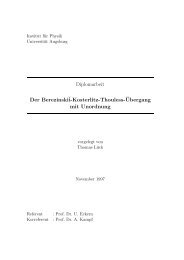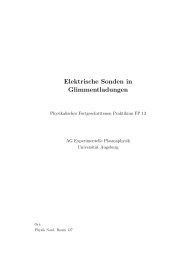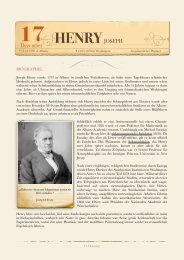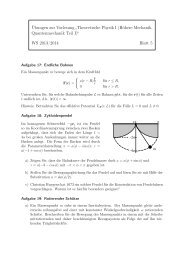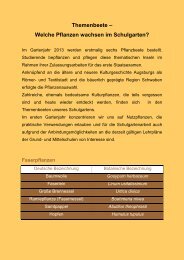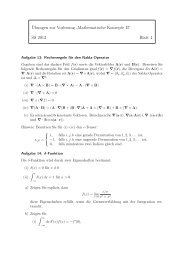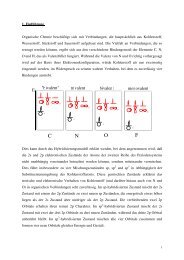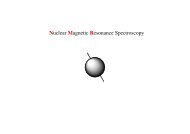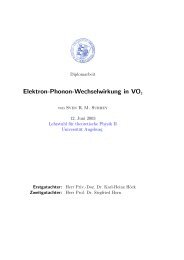Verschränkung - Institut für Physik
Verschränkung - Institut für Physik
Verschränkung - Institut für Physik
You also want an ePaper? Increase the reach of your titles
YUMPU automatically turns print PDFs into web optimized ePapers that Google loves.
<strong>Verschränkung</strong><br />
Krzysztof Byczuk<br />
<strong>Institut</strong>e of Physics, Augsburg University<br />
November 23th, 2005
What you would like to know about<br />
entanglement<br />
but you were afraid to ask
Main goal:<br />
• Entanglement is a quantum correlation in quantum many body<br />
system<br />
• Entanglement does not depend on particular physical representation<br />
• Entanglement is a resource like energy<br />
• Entanglement can be quantified and measured
Plan of the talk:<br />
1. EPR and Bell story (introduction of entanglement)<br />
2. How to use entanglement<br />
• no cloning theorem, quantum teleportation<br />
3. How to characterize entanglement<br />
• pure vs. mixed states entanglement<br />
• measures of entanglement<br />
4. How to quantify correlations in bulk systems<br />
5. Conclusions and outlook: correlations without correlata?<br />
6. Appendix<br />
• How to entangle photons, electrons, ...experimentally<br />
• Beating diffraction Rayleigh limit in classical wave optics
EPR theorem<br />
Einstein, Podolsky, Rosen (1935)<br />
H = H + ⊗ H −<br />
|Ψ〉 = [| ↑〉 − ⊗ | ↓〉 + − | ↓〉 − ⊗ | ↑〉 + ]/ √ 2<br />
−<br />
e<br />
0<br />
+<br />
π<br />
e<br />
π 0 → e + + e −<br />
S tot = 0 and S z = 0 - singlet state (Bohm 1954)<br />
Orthodox (Copenhagen) view:<br />
neither particle had either spin up or spin down until the act of measurement intervented: your measurment<br />
of e − collapsed the wave function, and instanteneusly “produced” the spin of e + 20 ly. far away<br />
EPR - |Ψ〉 does not provide a complete description of physical reality with locality principle<br />
spooky action at a distance, hidden variable, ghost field, ..., to keep locallity
EPR theorem today<br />
H = H + ⊗ H −<br />
locality<br />
|Ψ EPR 〉 = [| ↑〉 − ⊗ | ↓〉 + − | ↓〉 − ⊗ | ↑〉 + ]/ √ 2<br />
QM<br />
<strong>Verschränkung</strong> - entanglement (Schrödinger 1935)<br />
reality<br />
completness<br />
QM is nonlocal<br />
−<br />
e<br />
0<br />
+<br />
π<br />
e<br />
correlations over distance<br />
results of independent measurements will be correlated<br />
no superluminal transfer of information, energy, etc.
Bell theorem<br />
J. Bell (1964)<br />
any local hidden variable theory is incompatible with quantum<br />
mechanics<br />
• has found inequalities for correlation functions that are violated in<br />
QM (G. Boole (1862))<br />
• first approach to quantify entanglement<br />
• A. Aspect et al. (1982) first experiment<br />
• now many others, hopefully without loopholes<br />
NATURE ITSELF IS FUNDAMENTALLY NONLOCAL, EXPRESSED<br />
IN A SUBTLE CORRELATIONS BETWEEN TWO LISTS OF<br />
OTHERWISE RANDOM DATA
Bipartite pure entanglement<br />
Let {|i〉 A ⊗ |j〉 B } ∈ H = H A ⊗ H B and AB distinguishable.<br />
Any state<br />
|Ψ〉 = X ij<br />
γ ij |i〉 A ⊗ |j〉 B<br />
that cannot be represented as a product state is called an entangled<br />
state.<br />
• Entanglement is a quantum correlation which does not have a<br />
classical counterpart<br />
• any entangled state cannot be prepared from a product state by<br />
local operations and classical communications (LOCC)
Bell states<br />
• classical two level system (0 or 1) codes one bit of information<br />
• in QM two level system can be both 0 and 1 (spin, polarization,<br />
vortex, energy structure)<br />
• it was proposed to call it quantum bit or qbit (read: qiubit) in<br />
general - Schumacher (1995)<br />
Bell states - maximally entangled states of two qbits<br />
|Ψ − 〉 = 1 √<br />
2<br />
[|01〉 − |10〉]<br />
|Ψ + 〉 = 1 √<br />
2<br />
[|01〉 + |10〉]<br />
|Φ − 〉 = 1 √<br />
2<br />
[|00〉 − |11〉]<br />
|Φ + 〉 = 1 √<br />
2<br />
[|00〉 + |11〉]
No cloning theorem<br />
Wootters, Zurek, and Dieks (1982)<br />
the unknown quantum state cannot be copied<br />
a.a.<br />
let Û clon exists, i.e. Û clon |φ〉|0〉 = |φ〉|φ〉<br />
and |φ〉 = α|0〉 + β|1〉 unknown<br />
Û clon |φ〉|0〉 = |φ〉|φ〉 = (α|0〉+β|1〉)(α|0〉+β|1〉) = α 2 |00〉+αβ(|01〉+|10〉)+β 2 |11〉<br />
but<br />
Û clon |φ〉|0〉 = Ûclon(α|0〉+β|1〉)|0〉 = Ûclon(α|00〉+β|10〉) = α|00〉+β|11〉<br />
contradiction!
Quantum teleportation<br />
Bennett et al. (1993), photons (1998-2005), atoms (2004)<br />
Alice and Bob share one entangled state, e.g. |Φ + 〉.<br />
Alice wants to send to Bob all necessary information about the<br />
unknown quantum state |Φ〉 = a|0〉 + b|1〉 she has got such that<br />
Bob could recreate this state using a particle he has at hand. This is a<br />
task of quantum teleportation. The state at Alice will be destroyed.<br />
What about the entangled state they share?<br />
|Φ〉|Φ + 〉 ∼ [|Φ + 〉(a|0〉 + b|1〉) + |Φ − 〉(a|0〉 − b|1〉) + |Ψ + 〉(a|1〉 + b|0〉) + |Ψ − 〉(a|1〉 − b|0〉)]<br />
A: performs projective measurement on her 2 qbits - LO<br />
A: call Bob and tells her result (one of 4) - CC<br />
B: depending on A info performs 1 or σ x or/and σ z - LO<br />
cost: one Bell state is eatten up
Entanglement swapping<br />
Qbit at Alice can be in entangled state with another qbit<br />
Quantum teleporting one qbit she can exchange entanglement<br />
Entanglement is swoped between different particles<br />
Again it costs one Bell state
Mixed state<br />
• density operator ˆρ = P n p n|Ψ n 〉〈Ψ n | describes a system coupled<br />
to another system to which we do not have an access<br />
• pure state - maximal knowledge ˆρ 2 = ˆρ<br />
• mixed state - statistical knowledge, mixture of different pure states<br />
can lead to the same density operator and thereby the same mixed<br />
state<br />
• states from different ensembles having the same density operator<br />
are experimentally indistinguishable<br />
• when pure system has entangled subsystems then each subsystem<br />
is in a mixed state, e.g.<br />
reduced density operator<br />
|Ψ〉 = α|00〉 + β|11〉<br />
ˆρ A = Tr Bˆρ = Tr B |Ψ〉〈Ψ| = |α| 2 |0〉〈0| + |β| 2 |1〉〈1|
Entanglement in mixed state<br />
A mixed state is not entangled if there exists a convex decomposition<br />
into pure product state of its density operator, i.e.<br />
ˆρ = X n<br />
p n |Ψ n 〉〈Ψ n |<br />
with<br />
for each n.<br />
|Ψ n 〉 = |Ψ A n 〉|ΨB n 〉<br />
ˆρ sep = X n<br />
p nˆρ A ⊗ ˆρ B<br />
• mixture of separable states is always separable<br />
• mixture of entangled states need not be entangled (see example)
Mixture of Bell states<br />
ˆρ = 1 2 |Φ+ 〉〈Φ + | + 1 2 |Φ− 〉〈Φ − | = 1 2 |00〉〈00| + 1 2 |11〉〈11| =<br />
1<br />
2 [|0〉〈0| A ⊗ |0〉〈0| B + |1〉〈1| A ⊗ |1〉〈1| B ]<br />
• the mixed state can be realized by both an ensemble of maximally<br />
entangled states and an ensemble of product states<br />
• mixture is a process which destroys entanglement<br />
Example: Werner state<br />
is entangled for |λ| > 1/3.<br />
ˆρ = 1 (1 − λ) Id ˆ + λ|Ψ − 〉〈Ψ − |<br />
4
Entanglement concentration, purification<br />
and distillation<br />
For various application one needs to have maximally entangled states.<br />
How to get such states using only LOCC out of many nonmaximally<br />
entangled states?<br />
• Entanglement concentration - how to create maximally entangled<br />
pure state from not maximally entangled pure states<br />
• Entanglement purification - how to create maximally entangled<br />
pure state from mixed entangled states<br />
Both procedures are sometimes called distillation.<br />
Two general approaches considered:<br />
• global - operate on a large number of copies of a pure or mixed<br />
states, i.e. ˆρ ⊗n with n → ∞ - theoretically efficient but<br />
practically hard to realize<br />
• operates on a small number of copies - not so efficient but<br />
experimentally possible
Entanglement measures<br />
• finite regime - for a single copy of a quantum state<br />
• asymptotic regime - for n copies of a quantum state with n → ∞<br />
Maximally entangled state in pure bipartite states H d ⊗ H d<br />
|Φ max 〉 =<br />
dX<br />
i=1<br />
1<br />
√<br />
d<br />
|φ i 〉 ⊗ |φ i 〉<br />
Entanglement measure E(ˆρ) is a real-valued function<br />
satisfying reasonable postulates:<br />
E : ˆρ → E(ˆρ) ∈ R,
Entanglement measures postulates<br />
1. separability: E(ˆρ) = 0 for ˆρ separable<br />
2. normalization: E(ˆρ) = log 2 d for maximally |Φ max 〉 entangled<br />
state<br />
3. monotonicity: E(ˆΛˆρ) E(ˆρ) for any LOCC ˆΛ [LOCC does not<br />
increase entanglement]<br />
4. continuity: If ||ˆρ − ˆσ|| → 0 then E(ˆρ) − E(ˆσ) → 0<br />
5. additivity: E(ˆρ ⊗n ) = nE(ˆρ)<br />
6. subadditivity: E(ˆρ ⊗ ˆσ) E(ˆρ) + E(ˆσ)<br />
7. regularization: E ∞ (ˆρ) = lim n→∞ E(ˆρ ⊗n )/n exists<br />
8. convexity: E(λˆρ + (1 − λ)ˆσ) λE(ˆρ) + (1 − λ)E(ˆσ), for<br />
0 λ 1 [mixing does not increase entanglement]
Pure bipartite states<br />
relative von Neumann entropy (ˆρ = |Ψ〉〈Ψ|)<br />
E(|Ψ〉) = −Tr[ˆρ A log 2 ˆρ A ] = −Tr[ˆρ B log 2 ˆρ B ]<br />
Schmidt rank r (|Ψ〉 ∈ H A ⊗ H B , dimH A dimH B )<br />
|Ψ〉 =<br />
rX<br />
p i |˜Ψ A i 〉|˜Ψ B i 〉<br />
i=1<br />
r dimH A - number of nonzero terms in Schmidt decomposition<br />
(number of entangled degrees of freedom)
Pure bipartite states - example<br />
Single qbit<br />
Trγγ + = 1<br />
|φ〉 =<br />
2X<br />
γ ij |i〉 A |j〉 B<br />
ij=1<br />
E(|φ〉) = F( 1 2 + 1 2p<br />
1 − 4 det γγ+ )<br />
where<br />
F(x) = −x log 2 x − (1 − x) log 2 (1 − x)<br />
concurrency<br />
C = 2 p det γγ +<br />
Bell state γ = σ x<br />
C = 1, E = F(1/2) = 1, r = 2<br />
Product state |ii〉<br />
C = 0, E = F(0) = 0, r = 1
Mixed bipartite states<br />
not completely resolved because of the intricate relation between<br />
classical and quantum correlations in mixed states<br />
• E c - entanglement cost (minimal number of Bell states to create a<br />
given state using LOCC) [cont]<br />
• E D - entanglement of distillation (maximal number of Bell states<br />
extracted from a system using LOCC) [cont]<br />
• E F - entanglement of formation (optimized average von Neumann<br />
entropy of reduced density operators for pure states) [add]<br />
X<br />
E F (ˆρ) = min p i S(ˆρ i,red )<br />
{p i ,|Ψ i 〉}<br />
i<br />
• E R - relative entropy (distance between entangled ˆρ and the<br />
closest separated ˆσ) [add]<br />
(quite useful)<br />
• many others ...<br />
E R (ˆρ) = min[Trˆρ(log 2 ˆρ − log 2 ˆσ)]<br />
ˆσ<br />
E D E F E C
Multipartite systems<br />
• Quantum mutual information (Total correlation) between the two<br />
subsystems ˆρ 1 and ˆρ 2 of the joint state ˆρ 12<br />
I(ˆρ 1 : ˆρ 2 ; ˆρ 12 ) = S(ˆρ 1 ) + S(ˆρ 2 ) − S(ˆρ 12 )<br />
where S = −Trˆρ log 2 ˆρ von Neumann entropy<br />
• Quantum relative entropy between ˆσ and ˆρ<br />
S(ˆσ||ˆρ) = Tr[ˆσ(log 2 ˆσ − log 2 ˆρ)]<br />
• Quantum mutual information is a distance of ˆρ 12 to the closest<br />
uncorrelated ˆρ 1 ⊗ ˆρ 2<br />
I(ˆρ 1 : ˆρ 2 ; ˆρ 12 ) = S(ˆρ 12 ||ˆρ 1 ⊗ ˆρ 2 )<br />
• Multipartite quantum mutual information in ˆρ (generalization)<br />
I(ˆρ 1 : ˆρ 2 : ... : ˆρ n ; ˆρ) = S(ˆρ||ˆρ 1 ⊗ˆρ 2 ⊗...⊗ˆρ n ) = X i<br />
S(ˆρ i )−S(ˆρ)<br />
e.g. S(ˆρ||ˆρ MF ) = ln Z MF − ln Z + β〈H MF − H〉 H 0.
Entanglement for multipartite system<br />
Relative entanglement<br />
E(ˆρ) = minˆσ∈{separable} S(ˆρ||ˆσ)<br />
the relative entanglement is a distance between ˆρ and the closest<br />
classically correlated state<br />
If we take ˆσ = ˆρ MF (???)<br />
E(ˆρ) I(ˆρ)<br />
E(ˆρ) = ln Z MF − ln Z + β〈H MF − H〉 H<br />
χ = ∂2 ln Z<br />
∂B 2 ,<br />
χ sep − χ = ∂2 E(ˆρ)<br />
∂B 2<br />
+ β ∂2 〈H MF − H〉 H<br />
∂B 2<br />
Th. general bound for multipartite entanglement (Vedral 2003)<br />
E(ˆρ) ln Z MF − ln Z + β〈H MF − H〉 H .
Entanglement and the III law<br />
Nernst theorem says that S(T) → S 0 = const, or equivalently<br />
C V (T) = T(∂S(T)/∂T) V → 0 when T → 0.<br />
Th. Wiesniak et al. (2005): Only if entanglement develops at low<br />
temperatures the Nernst theorem is satisfied.<br />
because: separable states give bound for the ground state energy<br />
U(T = 0) E B and hence for all separable states<br />
C = ∂U(T)<br />
∂T<br />
= γ U(T) − E 0<br />
T<br />
γ ′ E B − E 0<br />
T 1(2)<br />
1 for gapless, 2 for gapped systems.<br />
Only when E B = E 0 , C(T) → 0<br />
In general C(T) → ∞ for all separable states.
Summary<br />
• Entanglement is a quantum correlation in quantum many body<br />
system<br />
• Entanglement does not depend on particular physical representation<br />
• Correlation without correlata<br />
• Entanglement is a resource for certain tasks<br />
• Entanglement can be quantified and measured
Source of entangled photons<br />
l=0<br />
l=1<br />
l=0<br />
parametric down-conversion, Kwiat et al. (1995)<br />
light emitting quantum dots, beam-splitters,...
Source of entangled fermions<br />
metal<br />
tunnel barrier<br />
(insulator)<br />
metal<br />
energy<br />
hole<br />
barrier<br />
electron<br />
Fermi sea<br />
E + eV<br />
F<br />
E F<br />
spin-entangled electron-hole pair<br />
V<br />
position<br />
voltage source<br />
Beenakker et al. (2003)<br />
| ↑〉 e | ↑〉 h + e iφ | ↓〉 e | ↓〉 h<br />
electron-electron scattering, quantum dots, Cooper pairs,<br />
Kondo scattering, ...



